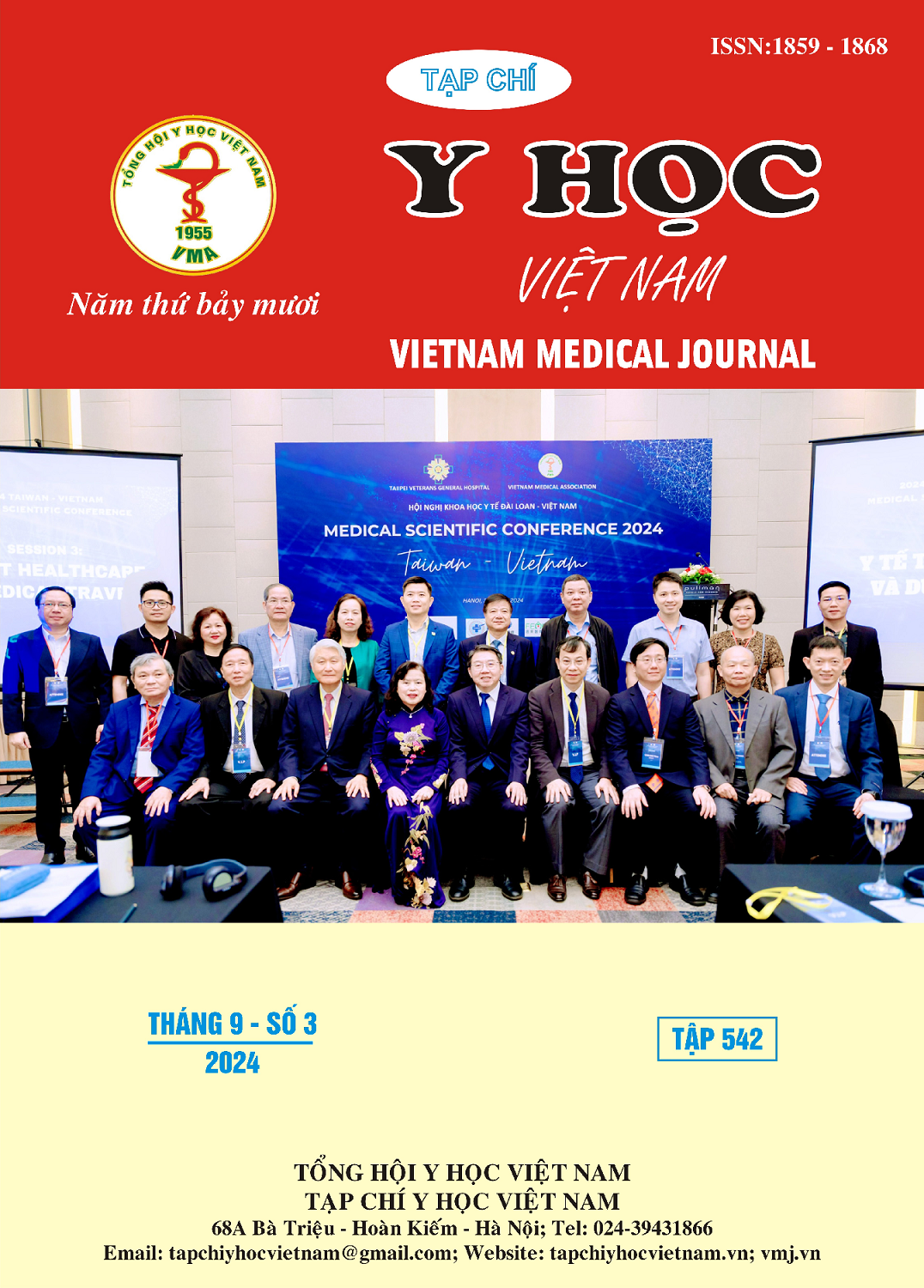CHARACTERISTIC OF LYMPH NODE METASTASIS IN ESOPHAGECTOMY WITH SEMIPRONE POSITIONS FOR ESOPHAGEAL CARCINOMA AT HA NOI MEDICAL UNIVERSITY
Main Article Content
Abstract
Objectives: To describe the clinical, paraclinical and rate of lymph node metastasis in patients undergoing esophagectomy with three field lymphadenectomy for esophageal carcinoma at Hanoi Medical University Hospital. Methods: A prospective descriptive study on 20 patients with esophageal carcinoma who underwent thoracoscopic-laparoscopic esophagectomy with semiprone positions. Results and discussion: Mean age 59.75 ± 6.96. All of the patients are male. The rate of neoadjuvant chemoradiotherapy was 75%. The middle third of the tumor accounted for 56.2%, the lower third accounted for 48.2%. Stages IIB and IIIB accounted for the most 31.5%, stages IA, IB, IIA all accounted for 12.5%. The average number of right neck lymphadenectomy is 13.8 ± 7.16, with 0% metastasis rate, the average number of left neck lymphadenectomy is 13.65 ± 4.8, with 5% metastasis rate. The number of lymph nodes along the right recurrent laryngeal nerve removed was 6.9 ± 3.7, with a metastasis rate of 2 cases accounting for 10%, the average number of lymph nodes along the left recurrent laryngeal nerve removed was 5.65 ± 4.85, with 5% metastasis rate. The average number of mediastinal lymphadenectomy was 18.85 ± 6.64, with a metastasis rate of 3 cases, accounting for 15%. The average number of abdominal lymph nodes removed was 11.95 ± 6.88 with 15% metastasis rate. Conclusions: The rate of cervical lymph node metastasis in our study is 5%, the rate of thoracic lymph node metastasis is 15% and the rate of abdominal lymph node metastasis is 15%
Article Details
Keywords
esophageal carcinoma, rate of lymph node metastasis.
References
2. Ando N, Ozawa S, Kitagawa Y, Shinozawa Y, Kitajima M. Improvement in the results of surgical treatment of advanced squamous esophageal carcinoma during 15 consecutive years. Ann Surg. 2000;232(2):225-232. doi:10.1097/00000658-200008000-00013
3. Nishimura E, Matsuda S, Takeuchi M, Kawakubo H, Kitagawa Y. Trends in Lymphadenectomy for Esophageal/ Esophagogastric Junction Cancer. Lymphatics. 2023;1(2): 77-86. doi:10.3390/ lymphatics1020008
4. Hagen JA, DeMeester SR, Peters JH, Chandrasoma P, DeMeester TR. Curative resection for esophageal adenocarcinoma: analysis of 100 en bloc esophagectomies. Ann Surg. 2001;234(4):520-530; discussion 530-531. doi:10.1097/00000658-200110000-00011
5. Hagens ERC, van Berge Henegouwen MI, Gisbertz SS. Distribution of Lymph Node Metastases in Esophageal Carcinoma Patients Undergoing Upfront Surgery: A Systematic Review. Cancers. 2020;12(6):1592. doi:10.3390/ cancers12061592
6. Lerut T, Nafteux P, Moons J, et al. Three-field lymphadenectomy for carcinoma of the esophagus and gastroesophageal junction in 174 R0 resections: impact on staging, disease-free survival, and outcome: a plea for adaptation of TNM classification in upper-half esophageal carcinoma. Ann Surg. 2004;240(6): 962-972; discussion 972-974. doi: 10.1097/01. sla.0000145925.70409.d7
7. Wang J, Yang Y, Shaik MS, et al. Three-Field versus Two-Field Lymphadenectomy for Esophageal Squamous Cell Carcinoma: A Meta-Analysis. J Surg Res. 2020;255:195-204. doi:10.1016/j.jss.2020.05.057
8. Bona D, Lombardo F, Matsushima K, et al. Three-field versus two-field lymphadenectomy for esophageal squamous cell carcinoma: A long-term survival meta-analysis. Surgery. 2022;171(4):940-947. doi:10.1016/j.surg.2021.08.029
9. Schwarz RE, Smith DD. Clinical impact of lymphadenectomy extent in resectable esophageal cancer. J Gastrointest Surg Off J Soc Surg Aliment Tract. 2007;11(11):1384-1393; discussion 1393-1394. doi:10.1007/s11605-007-0264-2


